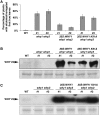A conserved lysine residue of plant Whirly proteins is necessary for higher order protein assembly and protection against DNA damage
- PMID: 21911368
- PMCID: PMC3245945
- DOI: 10.1093/nar/gkr740
A conserved lysine residue of plant Whirly proteins is necessary for higher order protein assembly and protection against DNA damage
Abstract
All organisms have evolved specialized DNA repair mechanisms in order to protect their genome against detrimental lesions such as DNA double-strand breaks. In plant organelles, these damages are repaired either through recombination or through a microhomology-mediated break-induced replication pathway. Whirly proteins are modulators of this second pathway in both chloroplasts and mitochondria. In this precise pathway, tetrameric Whirly proteins are believed to bind single-stranded DNA and prevent spurious annealing of resected DNA molecules with other regions in the genome. In this study, we add a new layer of complexity to this model by showing through atomic force microscopy that tetramers of the potato Whirly protein WHY2 further assemble into hexamers of tetramers, or 24-mers, upon binding long DNA molecules. This process depends on tetramer-tetramer interactions mediated by K67, a highly conserved residue among plant Whirly proteins. Mutation of this residue abolishes the formation of 24-mers without affecting the protein structure or the binding to short DNA molecules. Importantly, we show that an Arabidopsis Whirly protein mutated for this lysine is unable to rescue the sensitivity of a Whirly-less mutant plant to a DNA double-strand break inducing agent.
Figures






References
-
- Puchta H. The repair of double-strand breaks in plants: mechanisms and consequences for genome evolution. J. Exp. Bot. 2005;56:1–14. - PubMed
-
- Kimura S, Sakaguchi K. DNA repair in plants. Chem. Rev. 2006;106:753–766. - PubMed
-
- Nielsen BL, Cupp JD, Brammer J. Mechanisms for maintenance, replication, and repair of the chloroplast genome in plants. J. Exp. Bot. 2010;61:2535–2537. - PubMed
-
- Maréchal A, Brisson N. Recombination and the maintenance of plant organelle genome stability. New Phytol. 2010;186:299–317. - PubMed
Publication types
MeSH terms
Substances
Associated data
- Actions
- Actions
- Actions
Grants and funding
LinkOut - more resources
Full Text Sources
Molecular Biology Databases

